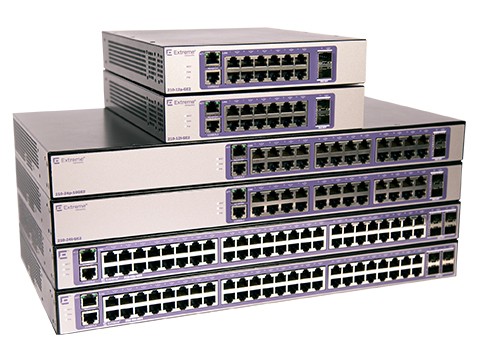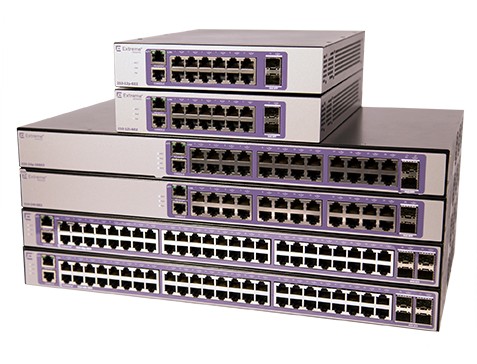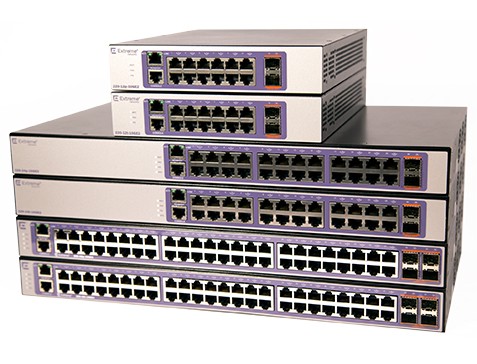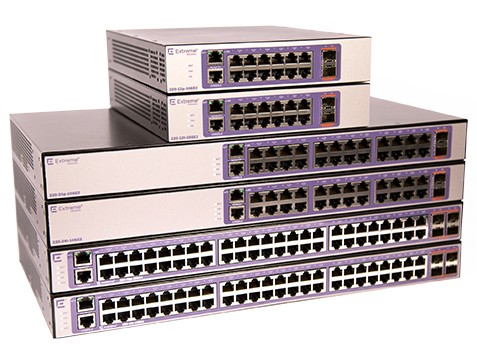Extreme Networks 200 Series
The ExtremeSwitching 200 Series is an economical, fixed-configuration family of managed Gigabit Ethernet Layer 2/3 switches designed for enterprises, branch offices and small to medium-sized businesses looking for key features in a flexible, yet easy-to-manage solution.
Consisting of 210 and 220 Series, each line is available in 12-, 24- and 48-port Gigabit PoE+ and non-PoE models. 210 Series models also have 2 or 4 SFP integrated ports for fiber uplinks; while 220 Series offers 2 or 4 integrated SFP+ ports for high-speed 10Gbps connectivity.
All 200 Series switches include a comprehensive Layer 2 feature set along with Layer 3 static routing of up to 64 routes. The 220 Series additionally supports dynamic IPv4 RIP routing with stacking of up to 4 switches.
The 200 Series flexible management options include cloud-based management via ExtremeCloud, a web browser-based GUI for quick set-up and ExtremeManagement for centralized provisioning, monitoring and troubleshooting. And for advanced users, the 200 Series has an integrated industry-standard CLI along with scripting capabilities.
All ExtremeSwitching 200 Series switches include a Limited Lifetime Warranty with advanced hardware replacement and are backed by Extreme Networks industry-leading services.
-
210 and 220 Series
- 12, 24 and 48 x 10/100/1000 Ethernet port models
- 12, 24 and 48 x 10/100/1000 Ethernet port models with IEEE 802.3at (PoE+)
- Non-blocking line rate performance on all ports
- Up to 50 access control lists (ACLs) for granular security control
- Fanless mode operation on 12-port PoE/non-PoE models
- Flexible management options including:
- ExtremeCloud
- Web GUI
- ExtremeManagement
- Industry-standard CLI with scripting capabilities
- Limited Lifetime Warranty
-
210 Series Specific Features
- 2 or 4 x 1000Base-X integrated SFP ports
- IPv4 static routing with support for up to 64 routes
-
220 Series Specific Features
- 2 or 4 x 10GBASE-X integrated SFP+ ports
- Stacking of up to four switches
- Dynamic Layer 3 (RIP) routing
- Redundant Power Supply option
| Switch Model | Ports | Performance | PoE Power |
|---|---|---|---|
| 210-12t-GE2 | 12 x 10/100/1000BaseT (RJ-45) ports 2 x 100/1000BASE-X (SFP) unpopulated ports 1 x Serial console port RJ-45 1 x 10/100BaseT out-of-band management port |
28 Gbps 20.8 Mpps |
N/A |
| 210-12p-GE2 | 12 x 10/100/1000BaseT PoE+ (RJ-45) ports 2 x 100/1000BASE-X (SFP) unpopulated ports 1 x Serial console port RJ-45 1 x 10/100BaseT out-of-band management port |
28 Gbps 20.8 Mpps |
150W |
| 210-24t-GE2 | 24 x 10/100/1000BaseT (RJ-45) ports 2 x 100/1000BASE-X (SFP) unpopulated ports 1 x Serial console port RJ-45 1 x 10/100BaseT out-of-band management port |
52 Gbps 38.7 Mpps |
N/A |
| 210-24p-GE2 | 24 x 10/100/1000BaseT PoE+ (RJ-45) ports 2 x 100/1000BASE-X (SFP) unpopulated ports 1 x Serial console port RJ-45 1 x 10/100BaseT out-of-band management port |
52 Gbps 38.7 Mpps |
195W |
| 210-48t-GE4 | 48 x 10/100/1000BaseT (RJ-45) ports 4 x 100/1000BASE-X (SFP) unpopulated ports 1 x Serial console port RJ-45 1 x 10/100BaseT out-of-band management port |
104 Gbps 77.4 Mpps |
N/A |
| 210-48p-GE4 | 48 x 10/100/1000BaseT PoE+ (RJ-45) ports 4 x 100/1000BASE-X (SFP) unpopulated ports 1 x Serial console port RJ-45 1 x 10/100BaseT out-of-band management port |
104 Gbps 77.4 Mpps |
380W |
| Switch Model | Ports | Performance | Power | PoE Power |
|---|---|---|---|---|
| 220-12t-10GE2 | 12 x 10/100/1000BaseT (RJ-45) ports 2 x 10GBASE-X (SFP+) unpopulated ports 1 x Serial console port RJ-45 1 x 10/100BaseT out-of-band management port |
64 Gbps 47.6 Mpps |
Internal | N/A |
| 220-12p-10GE2 | 12 x 10/100/1000BaseT PoE+ (RJ-45) ports 2 x 10GBASE-X (SFP+) unpopulated ports 1 x Serial console port RJ-45 1 x 10/100BaseT out-of-band management port |
64 Gbps 47.6 Mpps |
Internal | 150W |
| 220-24t-10GE2 | 24 x 10/100/1000BaseT (RJ-45) ports 2 x 10GBASE-X (SFP+) unpopulated ports 1 x Serial console port RJ-45 1 x 10/100BaseT out-of-band management port |
88 Gbps 65.5 Mpps |
Internal, Optional RPS | N/A |
| 220-24p-10GE2 | 24 x 10/100/1000BaseT PoE+ (RJ-45) ports 2 x 10GBASE-X (SFP+) unpopulated ports 1 x Serial console port RJ-45 1 x 10/100BaseT out-of-band management port |
88 Gbps 65.5 Mpps |
Internal, Optional RPS | 185W |
| 220-48t-10GE4 | 48 x 10/100/1000BaseT (RJ-45) ports 4 x 10GBASE-X (SFP+) unpopulated ports 1 x Serial console port RJ-45 1 x 10/100BaseT out-of-band management port |
176 Gbps 130.9 Mpps |
Internal, Optional RPS | N/A |
| 220-48p-10GE4 | 48 x 10/100/1000BaseT PoE+ (RJ-45) ports 4 x 10GBASE-X (SFP+) unpopulated ports 1 x Serial console port RJ-45 1 x 10/100BaseT out-of-band management port |
176 Gbps 130.9 Mpps |
Internal, Optional RPS | 380W |
| Switch Model | Weight | Dimensions |
|---|---|---|
| 210-12t-GE2 | 1.51 kg (3.33 lbs) | 4.4 cm (H) x 20.9 cm (W) x 25.5 cm (D) 1.73” (H) x 8.23” (W) x 10.0” (D) |
| 210-12p-GE2 | 1.93 kg (4.25 lbs) | 4.4 cm (H) x 20.9 cm (W) x 25.5 cm (D) 1.73” (H) x 8.23” (W) x 10.0” (D) |
| 210-24t-GE2 | 3.13 kg (6.90 lbs) | 4.4 cm (H) x 44.1 cm (W) x 25.4 cm (D) 1.73” (H) x 17.38” (W) x 10.0” (D) |
| 210-24p-GE2 | 3.68 kg (8.11 lbs) | 4.4 cm (H) x 44.1 cm (W) x 25.4 cm (D) 1.73” (H) x 17.38” (W) x 10.0” (D) |
| 210-48t-GE4 | 3.68 kg (8.11 lbs) | 4.4 cm (H) x 44.1 cm (W) x 25.4 cm (D) 1.73” (H) x 17.38” (W) x 10.0” (D) |
| 210-48p-GE4 | 4.51 kg (9.94 lbs) | 4.4 cm (H) x 44.1 cm (W) x 25.4 cm (D) 1.73” (H) x 17.38” (W) x 10.0” (D) |
| Switch Model | Weight | Dimensions |
|---|---|---|
| 220-12t-10GE2 | 1.51 kg (3.33 lbs) | 4.4 cm (H) x 20.9 cm (W) x 25.5 cm (D) 1.73” (H) x 8.23” (W) x 10.0” (D) |
| 220-12p-10GE2 | 1.88 kg (4.14 lbs) | 4.4 cm (H) x 20.9 cm (W) x 25.5 cm (D) 1.73” (H) x 8.23” (W) x 10.0” (D) |
| 220-24t-10GE2 | 3.21 kg (7.08 lbs) | 4.4 cm (H) x 44.1 cm (W) x 25.4 cm (D) 1.73” (H) x 17.38” (W) x 10.0” (D) |
| 220-24p-10GE2 | 3.69 kg (8.14 lbs) | 4.4 cm (H) x 44.1 cm (W) x 25.4 cm (D) 1.73” (H) x 17.38” (W) x 10.0” (D) |
| 220-48t-10GE4 | 3.82 kg (8.42 lbs) | 4.4 cm (H) x 44.1 cm (W) x 25.4 cm (D) 1.73” (H) x 17.38” (W) x 10.0” (D) |
| 220-48p-10GE4 | 4.50 kg (9.92 lbs) | 4.4 cm (H) x 44.1 cm (W) x 25.4 cm (D) 1.73” (H) x 17.38” (W) x 10.0” (D) |
System Specifications (210 and 220 Series)
- Up to 16,000 MAC addresses
- Up to 255 VLANs
- Up to 4 MSTP instances
- Up to 6 Link Access Groups (LAGs)
- Up to 50 ACLs with 10 rules per port
- Up to 8 Traffic Classes (or Queues)
Switching (210 and 220 Series)
Core Switching Features
- IEEE 802.1AB—Link Layer Discovery Protocol (LLDP)
- IEEE 802.1D—Spanning tree compatibility
- IEEE 802.1p—Ethernet priority with user provisioning and mapping
- IEEE 802.1s—Multiple spanning tree compatibility
- IEEE 802.1Q—Virtual LANs with port-based VLANs
- IEEE 802.1X—Port-based authentication with Guest VLAN support
- IEEE 802.1W—Rapid spanning tree compatibility
- IEEE 802.3—10BASE-T
- IEEE 802.3u—100BASE-T
- IEEE 802.3ab—1000BASE-T
- IEEE 802.1ak—Virtual Bridged Local Area Networks
- IEEE 802.3ac—VLAN tagging
- IEEE 802.3ad—Link aggregation
- IEEE 802.3x —Flow control
- GARP—Generic Attribute Registration Protocol:
- GMRP—Dynamic L2 multicast registration:
- GVRP—Dynamic VLAN registration
- RFC 4541—Considerations for Internet Group Management Protocol (IGMP) Snooping Switches
Advanced Layer 2 Features (210 and 220 Series)
- Authentication, Authorization, and Accounting (AAA)
- Broadcast Storm Recovery
- Broadcast/Multicast/Unknown unicast storm recovery
- DHCP Snooping
- IGMP Snooping Querier
- Multicast VLAN Registration (MVR)
- Industry Standard Discovery Protocol (CDP interoperability)
- Independent VLAN Learning (IVL) support
- IPv6 Classification APIs
- Jumbo Ethernet frame support
- Port MAC locking
- Port mirroring
- Protected ports
- Static MAC filtering
- TACACS+
- Voice VLANs
- Unauthenticated VLAN
- Internal 802.1X Authentication Server
- 802.1X Monitor Mode
- 802.1X Client Scaling
- CLI Filtering
- Switchport mode configuration
- Link Dependency
- IPv6 RA Guard (Stateless)
- Multi-switch Link Access Group (MLAG)
Routing
210 Series:
- IPv4/v6 Static Routes (up to 64 routes)
220 Series:
- Dynamic IPv4 Routing (RIP)
- IPv4/v6 Static Routing with up to 64 routes
- ECMP
- ICMP Throttling
- Loopback interfaces
- Multinetting
- ARP and Proxy ARP
- VLAN and port-based routing
- UDP Relay/IP Helper
- Policy-Based Routing
- Bidirectional Forwarding Detection
- RFC 1027 Using ARP to implement transparent subnet gateways (Proxy ARP)
- RFC 1058 Routing Information Protocol (RIP)
- RFC 1256 ICMP router discovery messages
- RFC 1812 Requirements for IP version 4 routers
- RFC 2082 RIP-2 MD5 authentication
- RFC 2131 DHCP relay
- RFC 2453 RIP v2
- RFC 3021 Using 31-Bit Prefixes on IPv4 Point-to-Point Links
Advanced Stacking (220 Series only)
- Up to 4 x 220 Series units in a single stack
- Single IP management of entire stack
- Cross-stack functionality, including LAGs, MSTP instances, VLANs, etc., spanning stack member units
- Configuration and firmware synchronization
- Automatic stack initialization and unit addition/removal and master failover
Quality of Service (210 and 220 Series)
Access Control Lists (ACLs)
- Permit/deny actions for inbound IP and Layer-2 traffic classification based on:
- Time-Based ACL
- Source/Destination IP address
- TCP/UDP Source/Destination port
- IP Protocol Type
- Type of Service (ToS) or differentiated services (DSCP) field
- Source/Destination MAC address
- EtherType
- IEEE 802.1p user priority (outer and/ or inner VLAN tag)
- VLAN ID (outer and/or inner VLAN tag)
- RFC 1858—Security Considerations for IP Fragment Filtering
Differentiated Services (DiffServ)
- Classify traffic based on same criteria as ACLs and optionally:
- Mark the IP DSCP or Precedence header fields
- Police the flow to a specific rate with two-color aware support
- RFC 2474—Definition of the differentiated services field (DS field) in the IPv4 and IPv6 headers
- RFC 2475—An architecture for differentiated services
- RFC 2597—Assured forwarding Per-Hop Behavior (PHB) group
- RFC 2697—Single-rate policing
- RFC 3246—An expedited forwarding PHB
- RFC 3260—New terminology and clarifications for DiffServ
Class of Service (CoS) Queue Mapping Configuration
- Auto-VoIP–Automatic CoS settings for VoIP
- IP DSCP-to-queue mapping
- Configurable interface trust mode (IEEE 802.1p, DSCP, or untrusted)
- Interface egress shaping rate
- Strict priority versus weighted scheduling per queue
System Facilities (210 and 220 Series)
- Event and error logging facility
- Run-time and configuration download capability
- PING utility
- Xmodem
- FTP Transfers via IPv4/IPv6
- Malicious Code Detection
- RFC 768—UDP
- RFC 783—TFTP
- RFC 791—IP
- RFC 792—ICMP
- RFC 793—TCP
- RFC 826—ARP
- RFC 894—Transmission of IP datagrams over Ethernet networks
- RFC 896—Congestion control in IP/TCP networks
- RFC 951—BOOTP
- RFC 1034—Domain names – concepts and facilities
- RFC 1035—Domain names – implementation and specification
- RFC 1321—Message digest algorithm
- RFC 1534—Interoperability between BOOTP and DHCP
- RFC 2021—Remote network monitoring management information base version 2
- RFC 2030—Simple Network Time Protocol (SNTP)
- RFC 2131—DHCP relay
- RFC 2132—DHCP options and BOOTP vendor extensions
- RFC 2819—Remote Network Monitoring Management Information Base
- RFC 2865—RADIUS client
- RFC 2866—RADIUS accounting
- RFC 2868—RADIUS attributes for tunnel protocol support
- RFC 2869—RADIUS Extensions
- RFC 3579—RADIUS support for EAP
- RFC 3580—IEEE 802.1X RADIUS usage guidelines
- RFC 3164—The BSD syslog protocol
- RFC 3580—802.1X RADIUS Usage Guidelines
- RFC 5176—Dynamic Authorization Server (Disconnect-Request processing only)
- RFC 5424—The Syslog Protocol
Management (210 and 220 Series)
- Industry-standard CLI
- IPv6 management
- Password management
- E-mailing of alerts
- Auto-install support for firmware images and configuration files
- SNMP v1, v2, and v3
- SSH 1.5 and 2.0
- SSL 3.0 and TLS 1.0
- Secure Copy (SCP)
- Telnet
- Web
- Java Plug-in 1.6.0_01 and Java Script 1.3
- RESTCONF
Advanced Management Features
- Industry Standard CLI with the following features:
- Scripting capability
- Command completion
- Context sensitive help
- Optional user password encryption
- Multi-session Telnet server
- Remote Switch Port Analyzer (RSPAN)
- ExtremeCloud cloud-based management
- Extreme Management Center support
Operating and Storage Conditions
210 and 220 Series
- Operating Temp: °0C to 40°C (32° F to 122° F)
- Storage Temp: -40° C to 70° C (-40° F to 158° F)
- Operating and Storage Relative Humidity: 10% to 95% (non-condensing)




